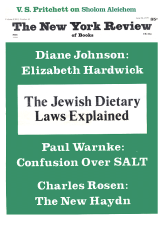In response to:
The Sitwell Show from the April 19, 1979 issue
To the Editors:
John Richardson’s review of John Pearson’s The Sitwells (NYR, April 19) is a rollicking piece full of infectious humor—who could resist the malicious wit of his suggestion that Osbert change his name to Hurt Hurt?—but it also contains a number of errors, three of which I discuss below.
Concerning Pearson’s discussion of the probability of Lawrence’s Sir Clifford Chatterley being modeled on Sir Osbert, Richardson asks, “But who until Pearson came along had realized that Osbert was the origin of D.H. Lawrence’s cuckolded, castrated baronet?” His implication that no one had perceived this is off the mark by at least twelve years. In 1967 two books appeared—John Lehmann’s A Nest of Tigers and Elizabeth Salter’s The Last Years of a Rebel—each of which suggests this possibility. Since Richardson depreciates Lehmann’s book elsewhere in his review for its “mindless encomiums of the Sitwells’ works,” it is curious that he does not remember Lehmann’s statement (p. 143) that Edith was convinced “that Lady Chatterley’s Lover was an attack on her family.” Salter further describes how Edith refused permission to use Renishaw for filming a version of the book because she believed that “Lawrence had used her family and her home as prototypes for Lady Chatterley’s Lover” (p. 30). It is difficult to see how either of these statements would not suggest an Osbert-Clifford analogy.
More serious (because it looks intentional) is Richardson’s “error” in englishing Montegufoni (the castle near Florence that Osbert inherited from his father) as “Hill of the Screech-owls.” Given the polemical high spirits of the review one can readily understand the exquisite appropriateness of such a locale for a Sitwell, especially Barone Osbert. But Richardson is here embellishing beyond reasonable limits: the fact is that gufo is the Italian for an ordinary owl (the kind traditionally associated with wisdom!). Screech-owl, a different bird, would be a different word, civetta, or possibly strige.
Still more disconcerting, because there is no excuse of wit for the resulting distortion, is Richardson’s deceptive omission of important information in charging the Sitwells with a lack of taste for the genuinely modern. He upbraids them for having “nearly persuaded Picasso to fresco the great hall at Montegufoni.” “In the end,” he asks then, “who got the seal of Osbert’s approval?’ According to Richardson’s immediate answer, it was “England’s tame romantic, John Piper, [whose] tasteful watercolors of Renishaw and Montegufoni are all too accurate a measure of the patron who commissioned them.”
This account appears to be deliberately deceiving. For Richardson certainly knows (Pearson gives the details) that when Osbert did not obtain Picasso he commissioned the cubist Gino Severini to do the work (which he did complete). But to acknowledge Osbert’s choice of Severini, a creditable modernist whose work, radically different from Piper’s, is now in the MOMA would considerably qualify Richardson’s indictment of the Sitwells as pseudo-modernists….
James D. Brophy
Professor of English
Iona College
New Rochelle, New York
John Richardson replies:
Errors indeed! Professor Brophy’s manifest themselves in every paragraph of his letter, not least the first. The “malicious” suggestion that Osbert Sitwell change his name to Hurt Hurt was not mine, alas, but, as my review specified, a quip of Evelyn Waugh’s.
Chatterley/Sitwell. In anticipation of nit-picking on this very point, I asked the New York Review researchers to help me check whether anyone other than Pearson had identified—in print, of course—Osbert Sitwell with D.H. Lawrence’s Clifford Chatterley. Before going to press, we were able to confirm that no one had done so, least of all John Lehmann and Elizabeth Salter who, as ardent Sitwell supporters, would never have publicly rubbed Osbert’s noble nose in Lawrence’s “impertinent” characterization. Far from “suggest[ing] this possibility,” Brophy’s quotes confirm that Lehmann and Salter were studiously vague about the Lawrentian connection and at pains to avoid linking the fictive with the future baronet. If there was a faint smell of rat, it emanated from Edith, whose hysterical attacks on Lawrence could be taken to indicate that she, rather than Osbert, had been travestied. Indeed, on Brophy’s evidence, or lack of it, one might infer that Edith, or her mother, or for that matter Osbert, modeled for Lady Chatterley.
Screech-owls. Brophy’s comments prove nothing beyond the fact that he has not read Pearson’s book. Had he done so, he would have avoided tumbling into the pettifogging pit prepared for the reviewer. The translation of Montegufoni as “Hill of the Screech-owls” is no figment of my “polemical high spirits,” but a quote from page 46 of Pearson’s book (hence the quotation marks). Pearson, I suspect, got the screech owls indirectly from Osbert, for this is how Brophy’s “Barone” occasionally referred to Montegufoni; and the “Barone” was, as I pointed out in my review, “an execrable linguist”; he also shared the Professor’s evident tendency to “embellish beyond reasonable limits.” So much for Brophy’s “gufo“!
Severini: Brophy is again in error. Severini was of course never a Cubist but a Futurist, and, by 1920, a discredited one. This artist’s post-war lapse into a retardataire decorative style, as exemplified by the Montegufoni frescoes, explains why the Museum of Modern Art owns only one painting by him, and it is of 1912. The choice of this feeble, flashy, ex-Futurist does Osbert even less credit than his advocacy of John Piper in the 1940s. In wartime England there were not many artists to choose from; in 1920, however, Osbert could have had his pick of the pioneers of the Modern Movement—all in their prime, all on the lookout for important commissions. By dragging in Severini, Brophy merely bolsters my case: the Sitwells were not “creditable modernists”—to borrow the Professor’s own odd phrase.
This Issue
June 14, 1979



